“Tom was a true man of Fordham, and we are proud to call him a Ram,” said Ed Kull, director of athletics at the University. “He will forever be in the Fordham history books, and his character, persistence, and determination will continue to inspire our Rams for generations.”
As a track star at Fordham, Courtney won numerous individual titles. He also anchored the Rams’ relay team that set a two-mile world record at the Los Angeles Coliseum Relays on May 21, 1954. Sports Illustrated featured him in his Fordham gear on the cover of its May 2, 1955, issue, one month before he earned a bachelor’s degree in political philosophy from Fordham College at Rose Hill.
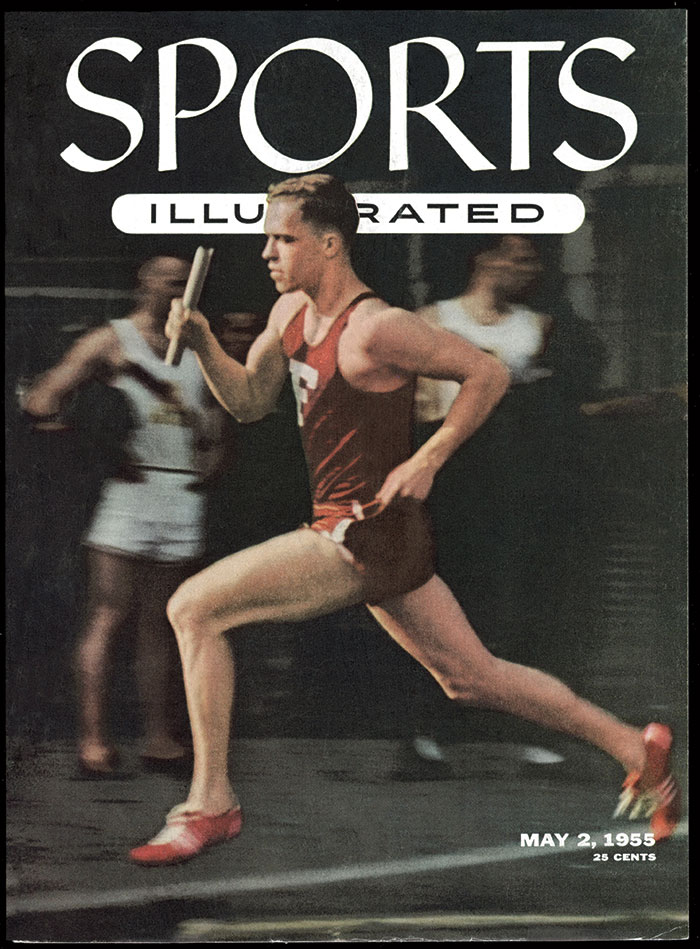
Courtney’s renown only grew after graduation, when he represented the U.S. at the 1956 Summer Olympics in Melbourne, Australia. He earned two gold medals—first in one of the most dramatic 800-meter races in Olympic history, then as the anchor of the 1,600-meter relay team.
“Few men have worked as hard and achieved such personal fame in such a short time as Fordham’s Tom Courtney,” student reporters Ronald Land and Bill Sturner wrote in The Ram less than two weeks later, upon Courtney’s triumphant return to campus.
A Record-Setting Track Star
Courtney was born on August 17, 1933, in South Orange, New Jersey. He grew up in nearby Livingston with dreams of becoming a professional baseball pitcher like his father, who had signed with the New York Yankees in 1928 and played in the minor leagues. Courtney played baseball and basketball, then switched to track in his junior year at James Caldwell High School in West Caldwell.
He received track scholarship offers from several universities, including Georgetown, Villanova, and Yale. He chose a full scholarship from Fordham after meeting coach Artie O’Connor at a New Jersey state meet. It was a decision that thrilled his mother, he once wrote, because her cousin Charlie Deubel was a 1935 Fordham graduate who had captained the Rams’ track team.
“While most runners are slender and wiry, Tom was broad-shouldered and muscular,” Raymond Schroth, S.J., FCRH ’55, wrote in his book Fordham: A History and Memoir, adding that the 6-foot-2-inch Courtney was “absolutely driven” and that “nothing was to get between Tom and his running.”
While competing for Fordham, Courtney won numerous high-profile races, including the 1,000-yard Metropolitan Collegiate and IC4A championships. He set a U.S. record in the 400-yard final at the Metropolitan AAU championship and a world record in the 600-yard final at the intercollegiate indoor championships. At the Washington Star games, an international invitational, Courtney bested the University of Pittsburgh’s Arnie Sowell, then considered the best runner in the world, by five strides.
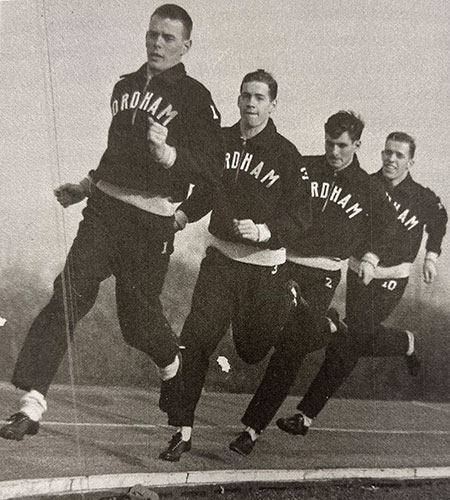
He formed a tight bond with his Fordham teammates Terry Foley, FCRH ’54, Frank Tarsney, FCRH ’54, and Bill Persichetty, GABELLI ’54. With Courtney as the anchor, the Rams’ “Fabulous Four” two-mile relay team recorded 13 straight wins in 1954.
Courtney also developed a close relationship with O’Connor, a 1928 Fordham graduate. During Courtney’s junior year, the coach “began mentioning the word Olympics to his star,” Father Schroth wrote. “For the next year and a half his training became both grueling and methodical as he kept a daily log of everything he did,” hoping to qualify for the 1956 games in Melbourne.
Qualifying for the Olympics—and a Date with Grace Kelly
Courtney had been a cadet in the Air Force ROTC program at Fordham, and after graduating in 1955, he was drafted into the Army. While completing basic training at Fort Dix in New Jersey, he continued to prepare for the Olympics, sometimes sneaking out of his bunk at night to run along the camp fence.
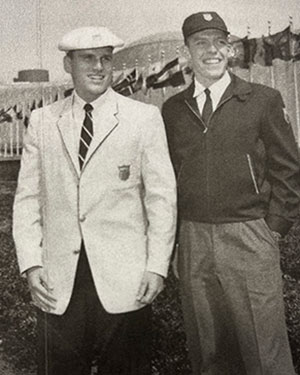
“After I graduated from Fordham, I was on my own,” Courtney recalled in his 2018 memoir, The Inside Track. “But I knew what to do and each day I tried to improve, to work a little harder, and to become a little faster.”
The Olympic trials were held in Los Angeles in July 1956, and Courtney made the team. Later, he and Olympic rower Jack Kelly Jr. were asked to model the official apparel members of the U.S. team would wear in Melbourne. They became friends, and “he asked me if I would go on a date with his sister, Grace Kelly, of movie fame,” Courtney wrote in his memoir. “We had a nice time and I asked her for another date. She said she was going to Monaco the next week, and the next thing I knew she was getting engaged to Prince Rainier.”
‘The Most Courageous Race I’ve Seen’
On November 26, 1956, the day of the 800-meter final at the Melbourne Olympics, Courtney’s nerves nearly got the better of him.
“As I stepped on the track, my legs went rubbery,” he wrote in The Inside Track. “I found that I could not stand up and I sagged to the grass. I saw the hundred thousand people in the stands, and thought, is it possible that I am so nervous that I won’t be able to run today?”
He took an early lead, then lagged behind his U.S. teammate and college rival, Arnie Sowell, who was favored to win the race. With 120 yards to go, Courtney made a move and eventually caught Sowell “on the turn and slowly passed him,” he later wrote, only to see Great Britain’s Derek Johnson spurt past him with just 50 yards to go.
“The sprint was over for me, my legs were getting rubbery, my head was bobbling, and my body stiffening. I was finished. … But I looked at the tape with just 40 yards to go and realized this was the only chance I would ever have to win the Olympics,” he wrote. “I did not want to finish thinking I might have put a little more into it. I leaned as far forward as I could and threw my arms out ahead of me.”
He crossed the tape one-tenth of a second ahead of Johnson, finishing with a time of 1:47.7, before collapsing from exhaustion.
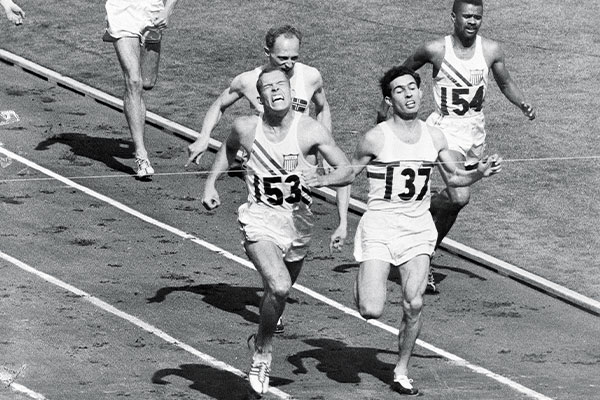
Journalist Bob Considine later called it “the most courageous race I’ve seen in 25 years of sportswriting.”
Courtney, however, was experiencing “a new kind of agony,” he later wrote. “I had never run myself into such a state. My head was exploding, my stomach ripping, and even the tips of my fingers ached. The only thing I could think was, ‘If I live, I will never run again!”
Five days later, he not only ran again, he earned his second gold medal, as the anchor of the 1,600-meter relay team. The 1956 Olympics were the last not shown live on television, so Courtney had to call his parents in Livingston to tell them he had won.
“Why was trying to win the 800 meters, the 400 meters, and the relay so important to me?” Courtney wrote in The Inside Track. “There was a poem by Sterling W. Sill taped to our refrigerator as we grew up. It read, ‘The average man’s complacent when he has done his best to score, but the champion does his best, and then he does a little more.’ I guess I saw triple in that quote.”
A Homecoming Parade in the Bronx
Upon returning to New York, Courtney appeared on The Ed Sullivan Show, and on December 12, 1956, his alma mater threw him a parade in the Bronx, from Poe Park on the Grand Concourse to the Rose Hill Gymnasium, where he received a “huge, triple-decked, silver trophy” from Fordham President Laurence J. McGinley, S.J., The Ram reported the next day.
The Fordham University Band led the procession through the Bronx, followed by the student body and the Livingston High School band. Wearing his white Olympics sport coat and a straw hat, Courtney rode down Fordham Road in the back of an open-top orange Cadillac—an experience he recounted in his memoir.
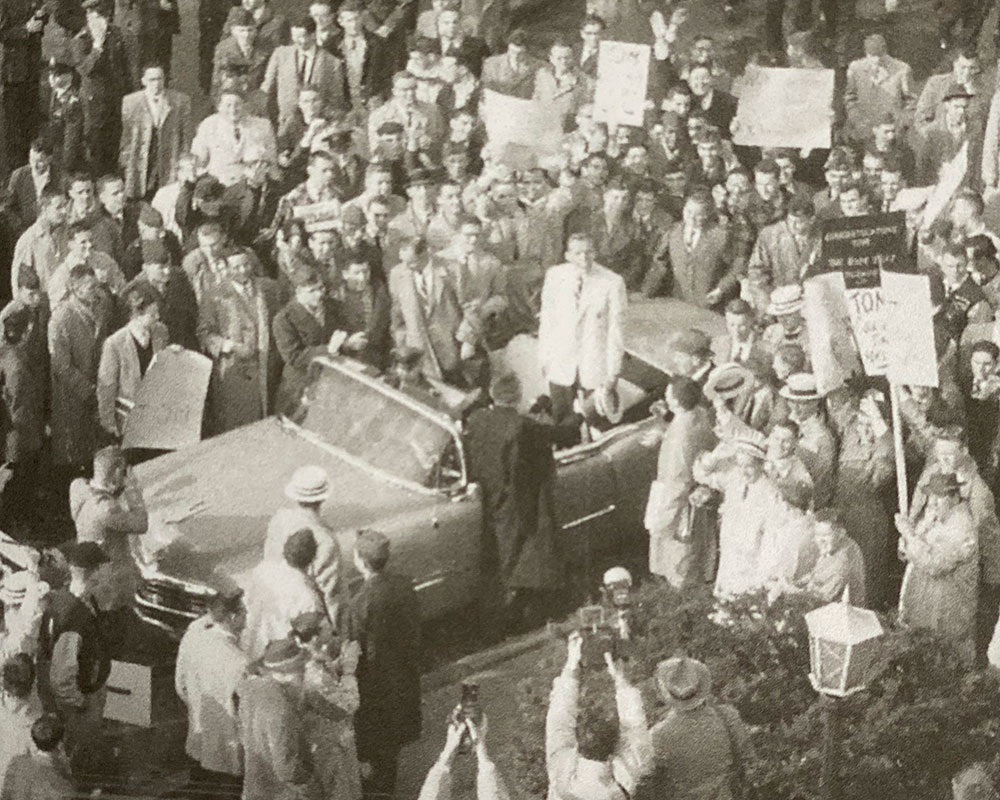
“That was a lovely time,” he wrote, “and I was in a convertible with my coach, Artie O’Connor. He was very motivational for me. As we went along, he took my losses much harder than I did. He was a dedicated, wonderful man. He loved Fordham and it helped me to love Fordham.”
Raising a Family, Building a Career
After the Fordham parade, Courtney returned to an Army base in Boston and continued to compete, setting a world record for the indoor 600-meter before retiring from competition in 1957, the same year he received an honorable discharge from the Army.
Two years later, he earned an M.B.A. from Harvard University (where he also served as an assistant track coach), setting the stage for a long, successful career in finance. He became a senior vice president of finance at Peninsular Insurance Company in 1962, and later worked as an investor at several firms before forming his own, Courtney Associates, in 1983. He specialized in portfolio management and venture capital before retiring in 2002.
In 1963, he married Posy L’Hommedieu. Together they had three sons: Tom Jr., Peter (who earned an M.B.A. from Fordham’s Gabelli School of Business in 1997), and Frank.
A Loyal Ram—and an Inspiration for Student-Athletes
Over the years, Courtney remained a loyal Fordham graduate and generous financial supporter of the University. He made gifts to the men’s and women’s track and field program, to the Fordham Fund, and the Joseph A. O’Hare, S.J., Endowed Presidential Scholarship Fund.
Courtney also was a frequent attendee at Jubilee reunion weekends at Rose Hill and regional alumni events in Florida, and while he could not attend the June 2022 reunion celebrations in person, he spoke with attendees via Zoom. With his wife, Posy, at his side in Florida, he took questions from his longtime friend and former Fordham track teammate Bob Mackin, FCRH ’55, in the Bronx.
“Fordham was a wonderful place, and I’m thankful for my experience there—and my scholarship too,” Courtney told the assembled Jubilarians and guests.

Along with Fordham and NFL football legend Vince Lombardi, FCRH ’37, Courtney was one of the first five people to be inducted into the Fordham Athletics Hall of Fame when it was established in 1971. He was inducted into the University’s Hall of Honor in 2011. And in 2016, to kick off Fordham’s track and field season, the program honored Courtney with a banner unveiling ceremony at the Vincent T. Lombardi Memorial Center at Rose Hill.
At his virtual Jubilee appearance in June 2022, Courtney received a special thank-you from Brian Horowitz, FCRH ’10, GSE ’11, head coach of the men’s track and field and cross country teams.
“Walking into the Lombardi Center each day and seeing the Olympic rings and knowing that you represented Fordham so well is a real inspiration for myself as a coach and for the current members of the team,” Horowitz said. “We hope to continue to make you proud.”
In addition to his wife, Posy, and their three sons, Courtney is survived by a brother, Kevin, and nine grandchildren.
—Adam Kaufman and Ryan Stellabotte
Watch Tom Courtney’s come-from-behind victory in the 800-meter race during the 1956 Summer Olympics. In this clip from “Greatest Thrills from the Olympics,” produced in the lead-up to the 1960 Olympics, host Bob Considine interviews Courtney, calling his epic victory “the most courageous race I’ve seen in 25 years of sportswriting.”


